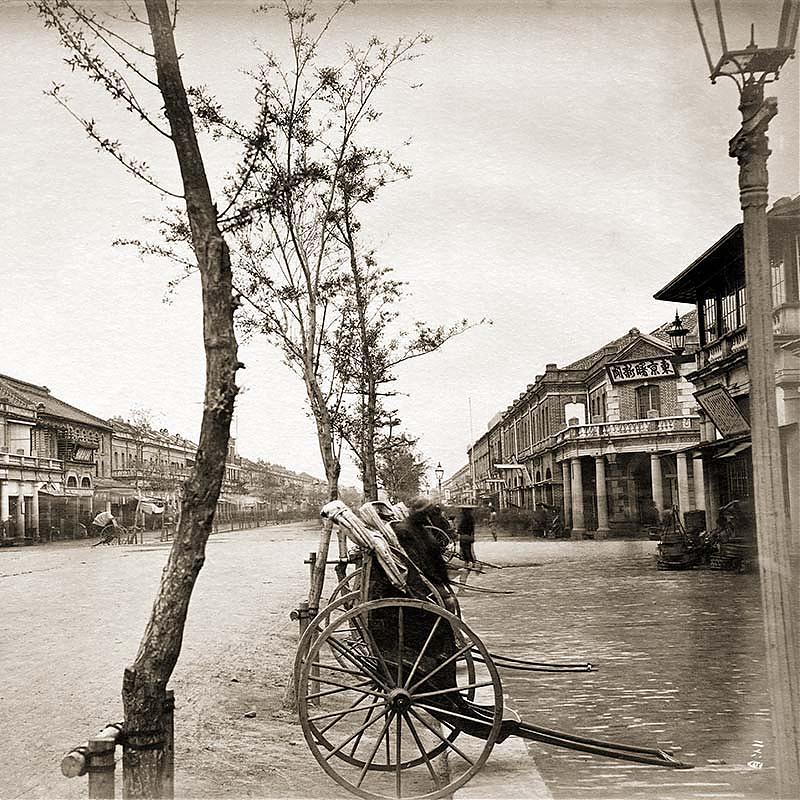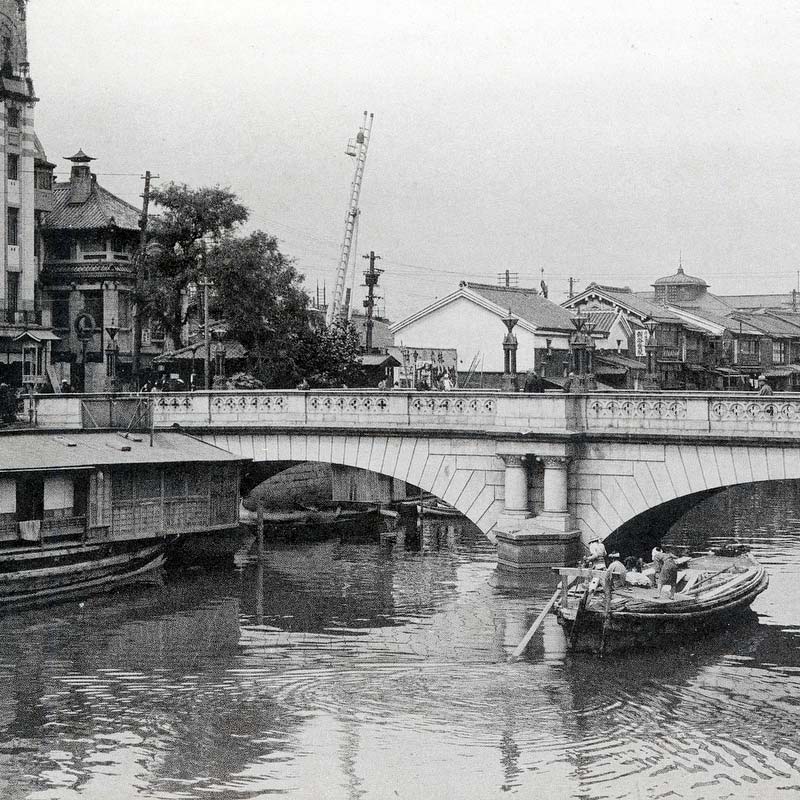A view on Nagasaki Harbor and the southern tip of the city’s foreign settlement. The main foreign settlement in Oura is behind the hill in the right background.
The lone pine tree located on that hill marks the location of the residence of the influential Scottish merchant Thomas Blake Glover (1838-1911). The house was completed in 1863 (Bunkyu 3) and is today the oldest extant Western-style building in Japan.
The area to the left of that is Kozone (小曾根). The Japanese houses in the front are located in Naminohira (浪の平). On the fields in the right foreground, a modern school (Chintei Elementary School, 尋常鎮鼎小学校) would be built in 1887 (Meiji 20). Several Western residences can already be seen, soon more would follow and by the early 1890s all the fields seen on this image were gone.1

On July 1, 1859 (Ansei 6), Nagasaki, together with Yokohama and Hakodate, was opened to foreign trade. In Nagasaki, foreign representatives and the local authorities decided that the mouth of the Oura river and the hillsides of Higashiyamate and Minamiyamate would be the best location for the new foreign settlement. While Oura would be the commercial district, the hillsides would function as residential areas.
Work to prepare the area for construction started in 1860 (Manen 1), and was completed in early 1862 (Bunkyu 2). By April, residents moved in. By the end of the 19th century, the settlement featured gracious Western-style buildings housing consulates, banks, companies, warehouses, hotels, shops and colonial-style villas with fantastic views of the bustling harbor.
Minamiyamate, often called “British Hill” because of the many British residents who lived here, was one of a total of six districts in Nagasaki’s foreign settlement. The other districts were Dejima (出島), Umegasaki (梅香崎), Oura (大浦), Oura-Sagarimatsu (大浦下り松) and Higashiyamate (東山手). Click on Nagasaki in the PLACES menu to see more photos of Nagasaki.

Notes
1 High-definition Image Database of Old Photographs of Japan, 3817 Nagasaki Harbour and Naminohira Minamiyamate. Retrieved on 2008-10-07.
2 Nagasaki Foreign Settlement Research Group, Minamiyamate District. Retrieved on 2008-10-07.
Published
Updated
Reader Supported
Old Photos of Japan aims to be your personal museum for Japan's visual heritage and to bring the experiences of everyday life in old Japan to you.
To enhance our understanding of Japanese culture and society I track down, acquire, archive, and research images of everyday life, and give them context.
I share what I have found for free on this site, without ads or selling your data.
Your support helps me to continue doing so, and ensures that this exceptional visual heritage will not be lost and forgotten.
Thank you,
Kjeld Duits
Reference for Citations
Duits, Kjeld (). Nagasaki 1870s: Minamiyamate, OLD PHOTOS of JAPAN. Retrieved on December 14, 2025 (GMT) from https://www.oldphotosjapan.com/photos/416/minamiyamate




June Denbigh
My husband’s family made a home and business in Nagasaki by the late 1870s.
Following is an excerpt taken from http://www.nfs.nias.ac.jp/page002.html#-D-
GEORGE DENBIGH
George Denbigh was born in Scotland circa 1838. Like other young British merchant adventures of his day, he made his way to Asia seeking fame and fortune. His first job there was operating a small seaweed business out of Chefoo, China. Denbigh frequently traveled between the ports of northeast Asia in various capacities related to trade in marine products. Most of his time was divided between Sakhalin, Vladivostok, Kamchatka, Hakodate and Nagasaki.
In the mid-1870s, Denbigh merged his business with that of a Jewish merchant from Vladivostok named Jacob L. Semenoff to form Semenoff and Company. Around this time, he also became a naturalized Russian citizen, probably in order to meet treaty provisions concerning trade between the Kuriles and Sakhalin.
He was clearly in Nagasaki by the late 1870s in connection with the introduction of whaling. While in Nagasaki, he met Moritaka Teshi (born 1853 in the neighboring town of Kikitsu), who bore him four sons and one daughter between 1879 and 1888. In April 1896, George Denbigh petitioned to marry Teshi, and did so the following month. The family had a residence at No. 25 Naminohira, a large Western-style house on a hill overlooking Nagasaki harbor. The house is currently on display at Meiji Village outside of Nagoya. The Denbighs spent most of their time, however, at the family home in Hokkaido.
The four Denbigh boys, Alfred (born 1879), Teddy [or Terry] (born 1883), Washington (born 1885), and John (born 1888), all worked at one time or another for the Semenoff-Denbigh business offices in East Asia. Alfred was sent to a mission school in Tokyo, and then on to the University of London, before returning to Hokkaido in 1900. Taught the family business by his father, he took over the main interests of the company around 1908. Using capital provided by the sale of family business interests in Sakhalin to the Japanese government after the Russo-Japanese War, Denbigh & Co. became independent in 1909, with sites established at Hakodate and Vladivostok.
On December 27, 1909, Teshi Denbigh (also known by her Christian name of Anna Rudolph Denbigh) died suddenly of apoplexy at the age of 54 at the family home in Nagasaki. At the time, her husband George and daughter Lisa (born 1886) were on route to Australia to pass the winter. Teshi was buried in the addition to Sakamoto International Cemetery.
In 1915, Lisa married Edward L.S. Gordon, the British Consul to Honolulu. Gordon had been assigned to the British consulate in Nagasaki in 1899 on a temporary basis, and was serving at the Hakodate office in 1914. George Denbigh accompanied his daughter and son in law to Honolulu where they took up residence in the British Consulate. George was already quite old at this time, however, and on November 15, 1916 he died of heart trouble at the age of 76. After a local funeral service, his body was cremated and sent to Nagasaki to be buried next to his wife.
Unfortunately, Lisa did not live much longer either. She died suddenly of appendicitis at Kauikeolani Children’s Hospital in Honolulu on April 21, 1919 at the age of 32, nine days after giving birth to a son (George Denbigh Steuart Gordon) at the hospital. According to a local Honolulu newspaper, “Mrs. Gordon was a social favorite and became readily endeared among Honolulu’s best families. She was an expert tennis player.” In a touching tribute to the tragically early death of the wife of the British Consul, Honolulu’s high society saluted Lisa in the best way it knew how — tennis matches were called off for the day!
Like her father, Lisa’s body was cremated and the ashes returned to Nagasaki. Edward Gordon, accompanied by a nurse and his infant son, left with the ashes on October 4 and seventeen days later Lisa Denbigh was laid to rest next to her parents in the town of her birth.
On August 8, 1920, Alfred Denbigh married Maria Gromadsky, a Russian actress who fled the country after the Revolution, and the elder sister of his brother John’s wife, Anna. Throughout the 1920s and early 1930s, Denbigh & Co. continued to prosper as an import- export company and a commission agency, with Alfred heading up operations in Hakodate and John supervising operations in London and Paris.
In 1939, Alfred, Maria, and Maria’s mother fled to Shanghai when it became too difficult to remain in Japan. After the war, they moved back to Yokohama and then Kamakura. Anna’s mother passed away in Kamakura in June 1952, and was followed in death by Alfred in November 1953. Maria died in Karuizawa in October 1967. All three bodies were transferred to the foreign cemetery at Yokohama in June 1988.
John Denbigh is also buried in the Yokohama foreign cemetery. He was preceded in death by his daughter Ludmila (born in Vladivostok on August 1914), who died from gunshot wounds inflicted by Japanese troops in Shanghai in June 1939). Ludmila’s body was later returned to Japan and buried at the Hakodate foreign cemetery. After John’s death, Anna (born February 1898 in Russia) married Konstantin Plezo in April 1966. Anna passed away in February 1988 and is buried in the same cemetery as the Denbighs.
#000447 ·
David Mackinnon
Hello, I read your article about the Denbighs with great interest. I believe George Denbigh is my great great uncle. His sister Eliza married my great grandfather, Henry Constable Smith and one of their sons, Lewis Valentine Smith (my maternal grandfather), went to Vladivostock and Japan to work with/for the Dendighs in the early 1900s. He lost a lot of money when the revolution happened and moved to Japan and finally returned to the UK in about 1928. I wondered if in your research you had ever come across my grandfathers name. If you did I would be extremely interested in hearing about him. My mother and all of her siblings are dead so I have no-one to ask. I live in Cornwall in the UK.
Many thanks
#000631 ·